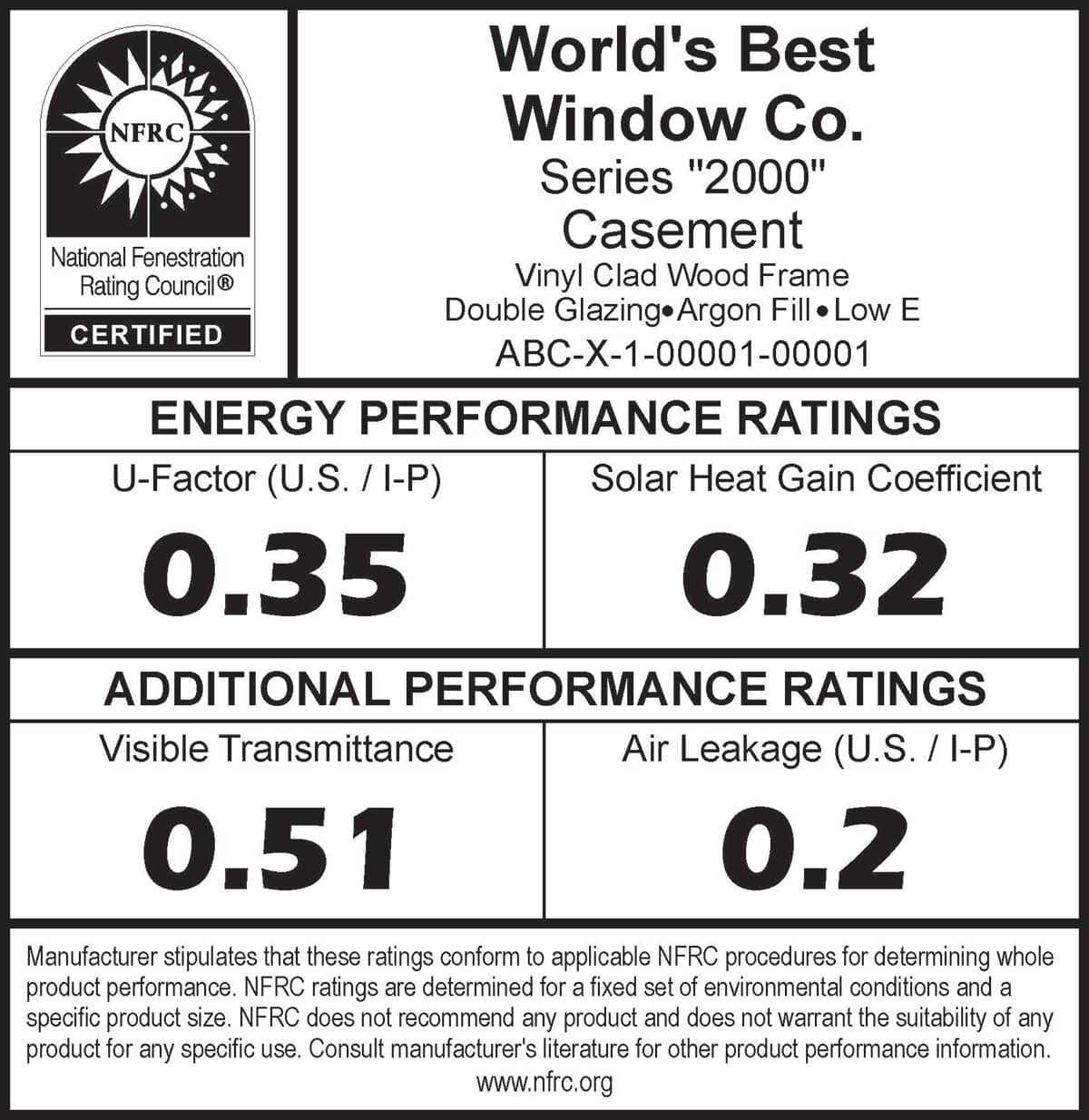
Here Is A typical Replacement Window Label.
BY JOHN KOLBASKA, OWNER
When you’re shopping for a car, you’ll notice a sticker on the window containing information including the MPG. You already know what MPG stands for, and if you’re searching for a fuel-efficient vehicle, you want that number to be high. It’s common knowledge.
Now try reading a replacement window sticker.
Common side effects include:
- Head scratching
- Continuous staring
- Head banging
- Confusion
- Blurriness from the continuous staring
- Talking to yourself
‘What am I reading? What do those numbers actually mean? What the heck is a U-factor?’
Seriously, it’s another language and confusing to the common customer. But in reality, most replacement windows today are durable. Double-pane with double-strength glass is standard and Low-E and argon gas is the norm in the Northeast.
But what’s up with all of these initials and numbers? Let’s break them down for you:
U-factor (U):
Rates how well the glass protects against heat loss. This number is important if you live in colder climates. You want this number to be 0.30 or less, which means it’s Energy Star certified. In our area of the Northeast, a 0.30 rating is sufficient, but if you’re living in Minnesota or Canada, you want that number to be even lower.
We at The Men With Tools carry an exclusive ThermaLast vinyl window with double pane glass, which has an industry leading U-factor of 0.21.
Solar heat gain coefficient (SHGC):
SHGC is how well the glass deflects the sun out of your home keeping not only the heat out, but also preventing your furniture from fading. Anything under a 0.30-rating is energy star qualified and makes sense for our area, but if you’re living in Arizona or Texas where the sun is beaming in 100-degree temps, you’d want that shgc-rating to be 0.20 or under.
Again, out exclusive ThermaLast Vinyl window has a Double-Pane Solar Ultra Glass package with an industry leading shgc-rating of 0.19, standard.
Visible transmittance (VT):
The higher the number, the easier it is to see outside your window. Some of these Low-E coatings have a dark tint where it’ll appear you’re looking through green-tinted sunglasses.
Our exclusive ThermaLast Glass has a vt-rating of 0.48, which is slightly darker than an inferior energy inefficient window. A fair trade off in our opinion for the maximum energy efficiency gains.
Condensation resistance (CR):
Actually means what it says — how resistant your windows are to condensation. This is how well the glass performs in a high, humid environment. If you do a lot of cooking, boiling, like to make tea, etc. you may want a window with a higher cr-rating.
Moisture on the surface of the glass isn’t a bad thing. If you can wipe it off with a towel, it’s not seal failure and won’t cause damage to your window. But if the condensation is in between the panes where you can’t clean it, then that’s a different story.
Our exclusive ThermaLast window has a cr-rating of 47 when most other window will have a cr-rating in the 40’s.
Air infiltration (AI):
(CFM — cubic foot per minute) is the amount of air that seeps into your home per minute. If you have a high CFM, you’re going to feel and sometimes even see the drafts that make you want to cry after seeing your monthly heating bill. The industry standard is 0.30 CFM. That’s the equivalent of 24 cans of soda leaking into your home per minute. If you’re replacing your windows because of draft issues, you should be targeting a lower AI rating.
Traditional wood residential double-hung windows by Pella, Marvin, Jeld-Wen and Andersen have a CFM of 0.23 (18.4 cans of soda) and traditional vinyl residential high-performance double-hung windows by Alside, Simonton and Champion have a 0.15 CFM (12 cans of soda per minute).
Our exclusive ThermaLast window has a 0.01 CFM which is equivalent to 1/2 a soda can of air per minute and is 3,000% more airtight than the industry standard.
Design Pressure (DP):
Staten Islanders are all too familiar with tropical storms and nor’easters, so it’s important to have a high dp structural rating. This is the strength of the vinyl.
“Our windows are made of virgin vinyl. When you grab them, they don’t feel like vinyl,” said The Men With Tools Owner John Kolbaska. “They’re not flimsy — they don’t feel like a flimsy piece of vinyl like these other cheaper window manufacturers have. When you grab it, it almost feels like a piece of metal — it’s solid.”
A dp-rating of 40 means the window can withstand winds up to 153 miles per hour, which is 63 percent over the industry minimum of 94 mph. Our window has a dp of 50, which is up to 171 mph winds — 82% over the industry minimum — before the frame would bend or snap. In comparison, cheaper window manufacturers have dp ratings in the 20’s and 30’s, which is less than 80 mph.
Our ThermaLast window carries the AAMA Gold Label (American Architectural Manufacturers Association), which means they meet the stringent performance standards for air, water and structural load.
Keep these numbers in mind and you won’t be surprised after your replacement windows are installed.
Are you in the market for replacement windows? Check out The Men With Tools on Staten Island, NY who won’t caulk and walk and will give you a fair price. Call us today at 347-815-4151 for a free estimate.
RELATED ARTICLES
Energy Savings Rebate!
On a Whole House
Of Windows
LIMITED TIME ONLY
I hereby consent to receive calls, text messages and emails from or on behalf of Home Exteriors By The Men With Tools at the telephone number and email provided above, including my wireless number, if applicable. I understand that consent is not a condition of purchase. For more information visit our privacy policy.
